The Carter Center celebrated its 40th anniversary in October. We asked some of our long-serving staff members to share a favorite memory from their time at the Center.
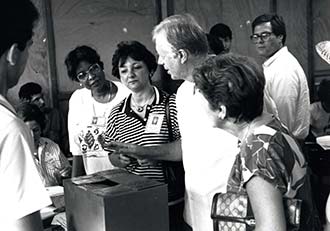
Under the leadership of President Carter, The Carter Center conducted its first election observation mission in Panama in 1989. Jennie Lincoln was there when he declared it fraudulent.
As a young staffer, I was excited to learn that former President and Carter Center founder Jimmy Carter would be leading an election observation mission to Panama in spring 1989. It was the Center’s first such mission and destined for a country in crisis led by military strongman Manuel Antonio Noriega.
President and Mrs. Carter, senior staffer Bob Pastor, and I met with General Noriega the night before the election. He was confident that his candidate would win.
Turns out, his confidence was based on the Panama Defense Forces falsifying tally sheets. And it might have worked. However, preparation of the tally sheets was labor intensive. Handwritten copies were produced at the polling stations and distributed to electoral officials and to political party poll watchers.
Those original records of the accurate counts at the tables provided the firsthand evidence for President Carter to confront the head of the counting board when the false reports were announced. I was with President Carter when he asked — in Spanish — “Are you an honest man, or are you a thief? You know these tally sheets are false.”
The official would not admit the fraud. We tried unsuccessfully to reach Noriega. No answer. President Carter called a press conference and explained how the fraud was taking place.
That first election observation laid the foundation for the 112 observations in 39 countries that have followed.
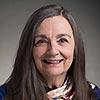
— Jennie Lincoln, senior advisor for Latin America and the Caribbean, worked for The Carter Center from 1989–1991 and 2015 to present
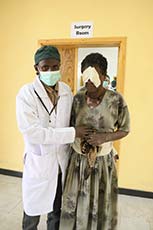
An Ethiopian woman is assisted after an eyelid surgery. Kelly Callahan remembers an emotional trip to Ethiopia where another woman thanked her for the same surgery.
In 2016, I was in Shewa Robit, a farming community in the Amhara region of Ethiopia. We were visiting a new community latrine, built to help combat trachoma, a devastating bacterial eye disease.
I was standing in awe of everything this community had done to fight this disease and improve their own lives when a woman approached me. She greeted me with the widest smile and took my hand and kissed it and put it to her forehead and then kissed it again and repeated this several times. My interpreter said that his woman was thanking me and The Carter Center.
She said she had received surgery in both eyelids the previous year. (This simple surgery, supported by The Carter Center, preserves sight and alleviates eye pain.) Her relief, as was explained to me, became her beacon. She told everyone in her community to get the surgery if they needed it and said her daughter also received the surgery.
As I heard the interpretation of her words and, more importantly, felt her emotions, we both cried. Mine were tears of joy for our collective ability to make life better for each other. I was in awe of our work, our focus, dedication, and ability to improve lives in partnership with the communities we serve. I was in awe of the courage and commitment of the woman before me.
I could not imagine a better life than having dedicated 25 years to working with The Carter Center to reduce suffering and save sight.
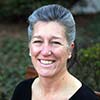
— Kelly Callahan, director of the Trachoma Control Program, began working for The Carter Center in 1998
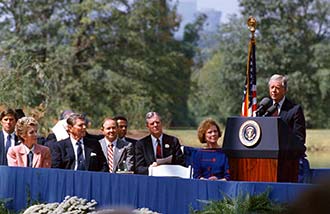
Former U.S. President Jimmy Carter addresses the crowd at the dedication of The Carter Presidential Center in 1986. Bernstine Hollis remembers the preparations for the event.
I was part of the White House staff as a presidential appointee and continued to work for the Carters as they moved from Washington to Atlanta. The Carters’ transition offices were housed in the Richard B. Russell Federal Building downtown. I remember watching a number of 18-wheelers bringing presidential papers across the street to be stored in an archive building until the presidential library was built.
A few years later, as we prepared to move from the Russell building into the new Carter Presidential Center, some of us pulled long nights ensuring everything was fit for the dedication, including awaiting a long list of dignitaries and guests.
I’ve been with The Carter Center ever since, and its growth has exploded far more than I ever thought it would. I think it’s due to the genuine love the Carters demonstrate — people appreciate it.
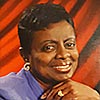
— Bernstine Hollis, senior accountant, began working for The Carter Center on its first day
I have so many wonderful memories from my time at The Carter Center. I was an observer at the 1999 Nigerian presidential elections. I helped organize awards ceremonies in Atlanta and Nigeria for countries that had eliminated Guinea worm disease. I’ve had the opportunity to meet heads of state and other notable people.
But I think the people I’ve met and formed friendships with are the most treasured. Silvia Sagastume works in our Guatemala office. We bonded years ago while planning an event together, and now we even take vacations together. I visited her a few years ago, and we managed to climb a live volcano together. It was an amazing experience.
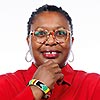
— Shandal Sullivan, executive administrative assistant, began working for The Carter Center in 1998
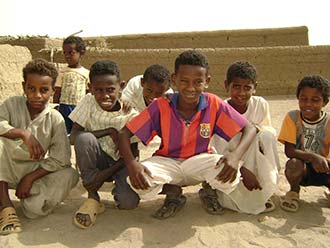
Frank Richards met these boys in 2007 in a remote region of Sudan and has always wondered what happened to them.
It was 2007, and I was in Sudan, working in a remote area next to the Nile River called Abu Hamed. Back then, it was the site of the northernmost focus of the parasitic disease river blindness in the world. The area’s isolation limited the breeding range of the black flies that spread the disease, so we were optimistic that it could be eliminated there if mass drug treatment could be provided twice a year.
But there was a glitch. A massive dam was soon to be constructed nearby. We thought it might create new fly breeding grounds downstream, so we went to talk to a community that would be displaced to this area of potential new risk about the importance of taking the medicine.
But upon arrival, a new concern troubled me as we walked through rows and rows of tall, beautifully cultivated date and palm oil trees; these ancient trees would soon to be submerged by the new dam. I was followed by a number of young boys. It struck me how their lives would soon be forever changed by the rising waters. Their parents, grandparents, and great-grandparents had cultivated these century-old trees that in turn provided for their livelihoods. These boys’ futures would no longer be tied to palm oil and dates. What would that mean for them?
In the end, our program in Abu Hamed was wildly successful and acclaimed as one of the first that eliminated river blindness in Africa. The spillways created by the dam we were so worried about did not result in an explosive bloom of biting black flies. Despite our success, however, I wonder what happened to those beautiful boys, now adults, who lost their lovely palm trees to the consequences of development.
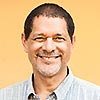
— Frank Richards, senior advisor for river blindness, lymphatic filariasis, schistosomiasis, and malaria; began working for The Carter Center in 1996
Please sign up below for important news about the work of The Carter Center and special event invitations.